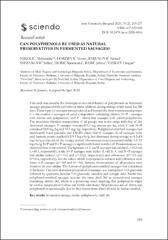| dc.description.abstract | This study was aimed at the investigation into the infl uence of polyphenols on fermented
sausages produced with and without nitrite addition, during storage which lasted for 280
days. Three types of sausages were produced and formed the three experimental groups:
C – the control – sausages of usual composition containing nitrites; N+P - sausages
with nitrites and polyphenols; and P - nitrite-free sausages with added polyphenols.
The proximate chemical composition of all groups was in the range with that of dry
fermented sausages. P sausages contained 0.3 mg nitrites per kg, while C and N+P
contained 54.8 mg/kg and 52.2 mg/kg, respectively. Polyphenol-enriched sausages had
signifi cantly lower peroxide and TBARS values than C sausages. In all sausages lactic
acid bacteria counts reached 8.9-9.9 log cfu/g, but decreased during storage to 4.3-4.8
log cfu/g at the end of the storage period. Micrococcaceae counts remained stable: 3.5-3.9
log cfu/g. In P and N+P sausages a signifi cantly lower number of Pseudomonadaceae was
observed than in the control. The lightness of C and P sausages was similar (L=50.2 and
L=49.5, respectively), while N+P sausages were darker (L=42.5). C and N+P sausages
had similar redness (a*=14.5 and a*=13.2, respectively) and yellowness (b*=5.9 and
b*=6.4, respectively), but the values which correspond to redness and yellowness were
lower in P sausages (a*=8.0 and b*=4.6). Sensory characteristics of all products were
found to be very similar. The fl avour of polyphenol-enriched sausages was considered
to be better. The most dominant polyphenol in sausages was kaempferol-3-O-glucoside
followed by quercetin, luteolin-7-O-glucoside, catechin and syringic acid. Nitrite-free
polyphenol-enriched sausages reached the same shelf life as conventional sausages
containing nitrites did, which is a promising result implying that polyphenols might
be used as natural preservatives and nitrite substitutes. Simultaneous use of nitrite and
polyphenols is questionable due to their interactions which should be further studied | en_US |

